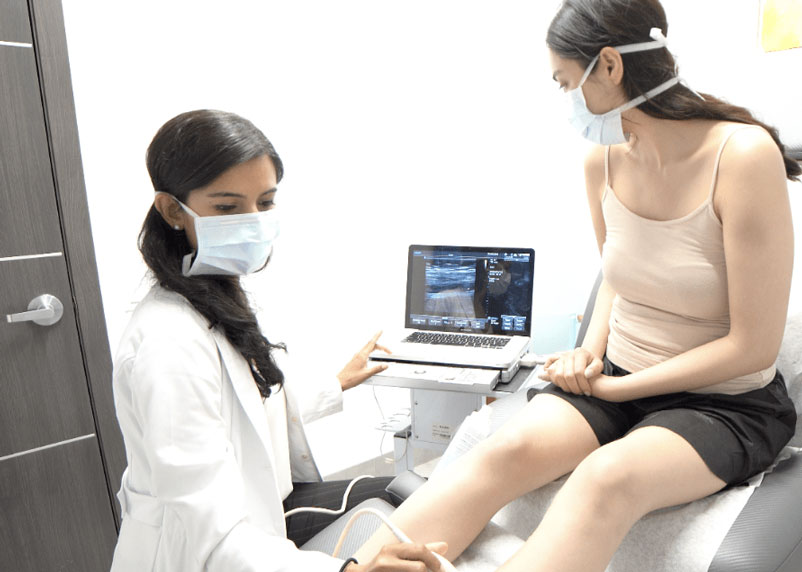We have an exceptionally talented vein doctor near River Oaks, Houston
The Spider Vein and Varicose Vein Clinic is led by an incredibly talented and compassionate vein doctor near River Oaks — Dr. Calvin Jung. When you book an appointment at our vein clinic in Houston, TX, your vascular health will be in our vein doctor’s capable hands. Dr. Jung ensures your vein testament process is extremely comfortable and pleasant. He also walks you through all of your vein treatment options and describes the entire process to ensure complete transparency and mental comfort. You can find our vein doctor at 2900 Weslayan St Suite 650, Houston, less than 5 minutes from River Oaks via San Felipe St and Maconda Ln.
We have recently noticed that most patients don’t have a strong understanding of minimally invasive vein treatments. Most patients assume that vein treatments are complex surgical procedures, whereas we absolutely avoid vascular surgery in favor of minimally invasive vein treatments. Others assume that spider veins and varicose veins are cosmetic problems, whereas they’re actually indicative of a dangerous circulatory disorder. This article aims to provide a comprehensive overview of the vein treatment process, from the initial consultation to the aftercare and recovery.
Step 1: The initial consultation involves a physical examination and a discussion
The spider vein and varicose vein treatment process starts with an initial consultation with the vein doctor. The vein doctor understands your specific goals and concerns and determines if you may have chronic venous insufficiency, the root cause of most vein conditions. Venous insufficiency is a medical condition wherein your vein valves malfunction, and blood flows backward, eventually accumulating in the leg veins. The accumulation of blood in leg veins leads to spider veins, varicose veins, and other vascular problems.
During your initial consultation, the vein doctor will perform a thorough physical examination to look for the signs of vein disease, such as spider veins and varicose veins. The vein doctor will also discuss your symptoms — leg heaviness, frequent leg cramps, restless leg syndrome, leg pain, and leg swelling are the most common signs and symptoms of vein disease. Furthermore, the vein doctor will review your medical history because patients with a history of vein problems have a higher risk of chronic venous insufficiency.
Step 2: We perform ultrasound diagnostic scans to identify chronic venous insufficiency
The vein doctor will perform ultrasound diagnostic tests, known as duplex ultrasound, to confirm the presence or absence of chronic venous insufficiency. During the duplex ultrasound scan, the vein doctor will move the handheld device over your legs to release ultrasound energy, thereby visualizing the direction of blood flow in your leg veins on a computer screen. This allows the vein doctor to diagnose chronic venous insufficiency with conviction. Furthermore, the diagnostic scan results also support your insurance claims.
Step 3: We curate a personalized vein treatment plan for spider veins and varicose veins
The vein doctor curates a personalized vein treatment plan for your specific requirements. Spider veins and varicose veins can be treated using numerous minimally invasive vein treatments, such as radiofrequency ablation, endovenous laser ablation, sclerotherapy, and more. The vein doctor selects the ideal vein treatments based on the location and size of your leg veins, whether you have chronic venous insufficiency, your medical history, and your insurance coverage options. Furthermore, the vein doctor will describe the entire vein treatment process to you.
Step 4: We perform minimally invasive vein treatments for venous insufficiency
If you have chronic venous insufficiency, the vein doctor will start with medically necessary minimally invasive vein treatments, such as radiofrequency ablation, endovenous laser ablation, and venaseal. These vein treatments collapse or destroy the diseased saphenous vein responsible for your vein conditions. Once the diseased vein is neutralized, the accumulated blood reroutes into healthier leg veins to restore optimal blood circulation to the heart. However, each vein treatment is performed using different methods.
During radiofrequency ablation, the vein doctor administers local anesthesia and makes a small incision on the skin’s surface. The incision is an entry point for a catheter, which is driven into the diseased saphenous vein under ultrasound guidance. Once the catheter is lodged in place, the vein doctor releases thermal energy to collapse the diseased vein, rerouting the accumulated blood into healthier leg veins. Endovenous laser ablation is similar to radiofrequency ablation, but it involves using laser energy instead of thermal energy.
VenaSeal is one of the latest minimally invasive vein treatments, having received FDA approval in 2015. During this procedure, the vein doctor injects a medical adhesive into the diseased saphenous vein to seal its walls shut. The diseased vein gets absorbed by the body, and the accumulated blood reroutes into healthier leg veins.
Step 5: We remove the superficial varicose veins and spider veins from your skin’s surface
After the primary vein treatment, the vein doctor focuses on cosmetic procedures to remove superficial varicose veins and spider veins. Ambulatory phlebectomy is the ideal procedure for superficial varicose veins — it involves the physical extraction of varicose veins through small incisions on the skin’s surface. Sclerotherapy is widely considered the most effective spider vein treatment — it involves injecting a sclerosant solution into the spider veins to fuse their walls shut and get them absorbed by the body.
Step 6: You can resume your daily activities and work immediately — no downtime
Minimally invasive vein treatments are in-office and outpatient procedures with no harsh side effects, complications, downtime. Your vein doctor will provide an overview of your aftercare guidelines, such as wearing compression stockings and avoiding heavy lifting, but you can resume your daily activities immediately. In fact, most of our patients seek minimally invasive vein treatments during their lunch break, so they don’t need to change their daily schedules.
Recent Comments